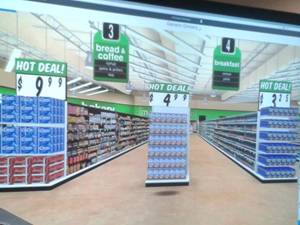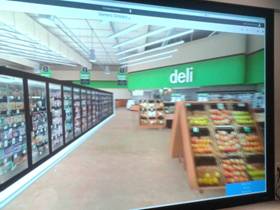CSNews Gets Inside Look at InContext Solutions' New ShopperLab
CHICAGO -- This week, a group of trade journalists, including editors from Stagnito Media’s Convenience Store News, Progressive Grocer and Private Label=>Store Brands magazines, were invited to witness the launch of InContext Solutions’ new ShopperLab, billed as "the first do-it-yourself, web-based shopper marketing platform to simulate in-store concepts on the fly."
Mark Hardy, InContext Solutions CEO, said while innovation centers are not new, "we found how to make it a level playing field for all retailers and manufacturers."
 InContext’s technology -- developed in partnership with BOI Solutions, AMD and Sony -- permits the creation of 3D store simulations, complete with planograms stocked with branded products, which users can navigate as if they were shopping in a real supermarket or convenience store.
InContext’s technology -- developed in partnership with BOI Solutions, AMD and Sony -- permits the creation of 3D store simulations, complete with planograms stocked with branded products, which users can navigate as if they were shopping in a real supermarket or convenience store.
It’s a breakthrough that will save time and money in the ever-hectic race to not only get new products into the marketplace, but figure out the most effective merchandising solutions to get them into shoppers' hands time after time.
"What we need to provide to our customers is speed and agility," Hardy said, describing his company’s mission as "taking technology and insights and giving it equally to everybody."
In a modest office on the third floor of a building across the street from the Sears Tower in downtown Chicago, ShopperLab features a wall-sized screen onto which is projected a web-based 3D simulation of a store that can be navigated from every conceivable angle.
While the platform, kno wn as ShopperMX, offers generic representations of stores across most retail channels, InContext can replicate a retailer's specific stores to their exact specifications. All it takes is a few hours to photograph the market, a few days to construct the digital model, and voila, instant store. Subsequent alterations can be done more quickly.
wn as ShopperMX, offers generic representations of stores across most retail channels, InContext can replicate a retailer's specific stores to their exact specifications. All it takes is a few hours to photograph the market, a few days to construct the digital model, and voila, instant store. Subsequent alterations can be done more quickly.
"The first thing we ask is your height," Hardy said, explaining the query to consumers surveyed using the system. "A 6-foot-2 man is a very different shopper than a 5-foot-4 woman."
With the image adjusted to the subject’s height and, hence, their shelf view, consumers can navigate the virtual store, grab products from shelves, read the packages and even interact with avatars representing store associates or other customers. The technology gauges shopper reaction to the environment, including movement and eye tracking. For example, Hardy said, "after someone is exposed to advertising, we can send someone into a store to see how they react."
 Retailers and manufacturers can lease ShopperLab to conduct research, or they can access the technology via the Internet from anywhere on practically any web-capable device, including laptops and tablets. They can upload specific planograms, drop pallets in aisles and simulate out-of-stocks to measure their impact on sales. "Anything you can do in an actual store, you can do in the virtual world," he declared, including changing signage, product mix, checkout location -- even the floor tiles.
Retailers and manufacturers can lease ShopperLab to conduct research, or they can access the technology via the Internet from anywhere on practically any web-capable device, including laptops and tablets. They can upload specific planograms, drop pallets in aisles and simulate out-of-stocks to measure their impact on sales. "Anything you can do in an actual store, you can do in the virtual world," he declared, including changing signage, product mix, checkout location -- even the floor tiles.
It’s all about creating a common platform for retailers and manufacturers to collaborate on strategies that help design a personalized shopper experience aimed at retaining a consumer’s loyalty. "Being able to do this in real time to see if you’ve caught a consumer’s eyes is the advantage of this platform," Hardy explained.
Beyond that, consumers can participate in a simulation wherever they have web access. "We can do this globally," he noted. "This technology is completely flexible."
Hardy said clients are gaga over the technology, released just three months ago. "Everybody we’ve shown this to has bought it," he said, noting a 70/30 split between manufacturers and retailers. "We had one retailer who thought it was too real."
InContext expects to have 15 virtual stores "built" by the end of the year. "There’s no IT deployment time," Hardy said. "It all resides on our cloud."
And InContext isn’t through. Stagnito Media editors got the chance to try out the next evolution: allowing consumers to actually enter the store simulation with virtual reality technology. Sporting an Oculus visor, consumers can roam the aisles of a virtual store.
While this aspect of ShopperLab is still in development, Hardy believes it will help retailers tap a younger demographic. "I think we can get young people [to participate] because this is a gaming environment and they’re used to it," he added.

